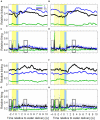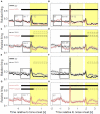Representation of Auditory Task Components and of Their Relationships in Primate Auditory Cortex
- PMID: 32372903
- PMCID: PMC7186436
- DOI: 10.3389/fnins.2020.00306
Representation of Auditory Task Components and of Their Relationships in Primate Auditory Cortex
Abstract
The current study aimed to resolve some of the inconsistencies in the literature on which mental processes affect auditory cortical activity. To this end, we studied auditory cortical firing in four monkeys with different experience while they were involved in six conditions with different arrangements of the task components sound, motor action, and water reward. Firing rates changed most strongly when a sound-only condition was compared to a condition in which sound was paired with water. Additional smaller changes occurred in more complex conditions in which the monkeys received water for motor actions before or after sounds. Our findings suggest that auditory cortex is most strongly modulated by the subjects' level of arousal, thus by a psychological concept related to motor activity triggered by reinforcers and to readiness for operant behavior. Our findings also suggest that auditory cortex is involved in associative and emotional functions, but not in agency and cognitive effort.
Keywords: agency; classical conditioning; instrumental conditioning; monkey; sound (audio) processing.
Copyright © 2020 Knyazeva, Selezneva, Gorkin, Ohl and Brosch.
Figures





Similar articles
-
Behavioral semantics of learning and crossmodal processing in auditory cortex: the semantic processor concept.Hear Res. 2011 Jan;271(1-2):3-15. doi: 10.1016/j.heares.2010.10.006. Epub 2010 Oct 29. Hear Res. 2011. PMID: 20971178 Review.
-
Neuronal activity in primate auditory cortex during the performance of audiovisual tasks.Eur J Neurosci. 2015 Mar;41(5):603-14. doi: 10.1111/ejn.12841. Eur J Neurosci. 2015. PMID: 25728179
-
Multiple representations of information in the primary auditory cortex of cats. I. Stability and change in slow components of unit activity after conditioning with a click conditioned stimulus.Brain Res. 2000 Jun 16;868(1):56-65. doi: 10.1016/s0006-8993(00)02276-9. Brain Res. 2000. PMID: 10841888
-
Operant conditioning of neural activity in freely behaving monkeys with intracranial reinforcement.J Neurophysiol. 2017 Mar 1;117(3):1112-1125. doi: 10.1152/jn.00423.2016. Epub 2016 Dec 28. J Neurophysiol. 2017. PMID: 28031396 Free PMC article.
-
Processing of complex sounds in the auditory cortex of cat, monkey, and man.Acta Otolaryngol Suppl. 1997;532:34-8. doi: 10.3109/00016489709126142. Acta Otolaryngol Suppl. 1997. PMID: 9442842 Review.
Cited by
-
Functional network properties of the auditory cortex.Hear Res. 2023 Jun;433:108768. doi: 10.1016/j.heares.2023.108768. Epub 2023 Apr 12. Hear Res. 2023. PMID: 37075536 Free PMC article. Review.
-
Comparison of Pupil Dilation Responses to Unexpected Sounds in Monkeys and Humans.Front Psychol. 2021 Dec 23;12:754604. doi: 10.3389/fpsyg.2021.754604. eCollection 2021. Front Psychol. 2021. PMID: 35002851 Free PMC article.
-
Correlates of Auditory Decision-Making in Prefrontal, Auditory, and Basal Lateral Amygdala Cortical Areas.J Neurosci. 2021 Feb 10;41(6):1301-1316. doi: 10.1523/JNEUROSCI.2217-20.2020. Epub 2020 Dec 10. J Neurosci. 2021. PMID: 33303679 Free PMC article.
-
Dissociation of task engagement and arousal effects in auditory cortex and midbrain.Elife. 2021 Feb 11;10:e60153. doi: 10.7554/eLife.60153. Elife. 2021. PMID: 33570493 Free PMC article.
References
LinkOut - more resources
Full Text Sources

